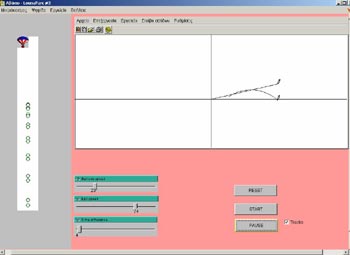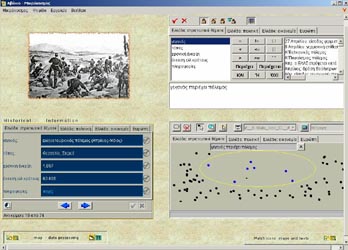THE AMUSEMENT PARK
|
In a kiosk at an amusement park a clown lets a small balloon (with hellion) up to the air. The players after a send-off throw a small ball with the aim of hitting the balloon. You can play and have a try to hit the balloon. You can change the initial parameters, experiment while foreseeing if the ball will hit the balloon. What does each window represent? How does the one representation differ from the other? Study the program that regulates the simulation and make changes in the rules of the game!
The basic idea of the above scenario, which has been applied in the third grade of high-school, is the observation and the experimentation with different kinds of movements (linear smooth, linear smoothly accelerating) through multiple representa-
|
 |
 |
| tions of them on computer screen. Students have the chance to check the basic parameters of movement and to experiment defining the values of the initial velocity of the balloon as well as the time lapse between the departure of the balloon and the moment of sending off the ball. They can make conjectures about what is going to happen and play conjecture games with each other. Finally they can change the laws of motion and find out what would have happened if Newton had formulated different laws! |
download


 |
-------------------------------------------------------------------------------------------------
|
CREATING A POSTER FOR A WAR OF THE PERIOD 1850 – 1950
|
Travel back in time and imagine that you are a merchant, a military, a laborer or a farmer … in Greece during the period 1850 – 1950. Choose a war in which Greece was involved during this period and create a poster for or against the war according to the beliefs and interests of the social party that you belong.
The exploration using the software 'historical facts' is focused in the reconstruction by the students of the period 1850 – 1950 through the selection, synthesis and comparison of historical information. This activity asks the students to take a critical stance towards historical facts and to compose a narrative of what could have happened during this period viewed from different perspectives. These narratives will be written collaboratively in groups. Students' narratives can then be the
|
 |
 |
| subject of a discussion at a classroom level not only about historical facts but also about the processes and the methods used by historians that compose narratives based on historical records and evidences. The activity is applied at the end of high school and at the fist classes of lyceum (students aged 15 to 17 ). |
download 


|